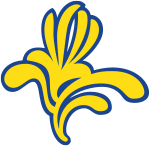Brussels International Exposition (1897)
| EXPO Brussels 1897 | |
|---|---|
 Exhibition poster by Art Nouveau artist Henri Privat-Livemont | |
| Overview | |
| BIE-class | Universal exposition |
| Category | Historical Expo |
| Name | Exposition Internationale de Bruxelles |
| Building | Paleis der Koloniën |
| Area | 36 Ha |
| Visitors | 6,000,000 |
| Participant(s) | |
| Countries | 27 |
| Location | |
| Country | Belgium |
| City | Brussels |
| Venue | Jubelpark |
| Coordinates | 50°50′30″N 4°23′19.4″E / 50.84167°N 4.388722°E |
| Timeline | |
| Opening | May 10, 1897 |
| Closure | November 8, 1897 |
| Universal expositions | |
| Previous | World's Columbian Exposition in Chicago |
| Next | Exposition Universelle (1900) in Paris |
The Brussels International Exposition (Exposition Internationale de Bruxelles) of 1897 was a World's fair held in Brussels, Belgium, from May 10, 1897 through November 8, 1897. There were 27 participating countries, and an estimated attendance of 7.8 million people.
The main venues of the fair were the Cinquantenaire Parks and a colonial section at Tervuren showcasing King Leopold II of Belgium's personal property, the Congo Free State. The two exposition sites were linked by a purpose-built tramway.
Colonial exhibit
The Tervuren section was hosted in the Palace of the Colonies (although there was only one colony), designed by Belgian architect Albert-Philippe Aldophe. In the main hall Georges Hobé designed a distinctive wooden Art Nouveau structure to evoke the forest, using Bilinga wood, an African tree. The interior exhibition displayed ethnographic objects, stuffed animals and in the "Hall of the Great Cultures" Congo's most important export products were displayed: coffee, cacao and tobacco. In the park, an example Congolese village was built, where 267 Africans lived through the period of the fair.[1] The success of this exhibition led to the permanent establishment of the Royal Museum for Central Africa in 1898.
Art Nouveau
The primary designers of the fair were among of the Belgian masters of Art Nouveau architecture at the height of the style: Henry van de Velde, Paul Hankar, Gédéon Bordiau, and Gustave Serrurier-Bovy. Henri Privat-Livemont produced posters for the exposition.
There seem to be few physical remnants. The small neo-classical pavilion called the Temple of Human Passions that Victor Horta designed to house a sculptural relief by Jef Lambeaux was completed in time for the fair, but its opening was delayed by disputes until 1899.
Vieux-Bruxelles
A public favorite at the World’s fair was Vieux-Bruxelles (also called Bruxelles-Kermesse), a miniature city and theme park evoking Brussels around 1830. Conceived by George Garnir, and designed by Jules Barbier (not to be confused with the Parisian author), Gombeaux and Ghyssels, with dioramas painted by Albert Dubosq, Pierre Devis and Armand Lynen, the section occupied 25,000 square meters of the Cinquantenaire park. Its construction was begun on 19 October 1896 and its inauguration took place on 24 April 1897. Somewhat foreshadowing Main Street at Disneyland, Vieux-Bruxelles offered visitors nostalgic, smaller-size reproductions of historic buildings. As Charles Vogel put it,
Bruxelles-Kermesse, c’est la cité populaire avec ses distractions nombreuses, ses plaisirs à la bonne franquette, ses éléments de gaieté partout renouvelés. … Le visiteur est frappé tout d’abord par un ensemble de constructions diverses : maisons, portes monumentales, tours, parmi lesquelles se dresse majestueusement celle du restaurant du Chien-Vert. … Ce n’est pas un musée, un groupement archaïque, c’est une vieille ville. C’est notre vieille ville avec – ramenées à une échelle légèrement réduite – ses constructions d’antan, dont quelques-unes encore existantes ont été copiées fidèlement et donnent, grâce au staff, l’illusion absolue de la réalité. … L’entrée de Bruxelles-Kermesse, c’est la porte du Rivage, puis viennent la maison du comte d’Egmont, la maison des Trois-Têtes, l’auberge Saint-Laurent, contiguë à l’Hôtel Ravenstein, – la maison du Cheval marin, le vieux marché au Beurre, l’hôtel de Nassau, – qui, avec sa superbe tour à flêche piriforme, done asile au restaurant estaminet du Chien vert déjà nommé, – la vieille porte de Gand ou de Flandre, d’un illusionisme stupéfiant ; la fontaine de Manneken-Piss [sic] et celle des Trois Pucelles … Faut-il parler du Moulin Saint-Michel, de la maison aux Barques, de la porte de l’ancienne église Sainte-Catherine ?[2]
Commemoration
.jpg) Commemorative stamp and postmark.
Commemorative stamp and postmark..jpg) Postcard.
Postcard.
External links
| Wikimedia Commons has media related to Exposition Internationale de Bruxelles (1897). |
- Brussels International Exposition pdf
- International Exhibition of Brussels 1897
- BIE description (in French; pdf format)
- photos of the Congo display
References
- ↑ Hochschild, Adam. King Leopold's Ghost.
- ↑ L’Éventail, 25 April 1897.
